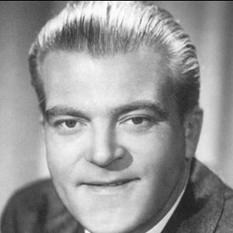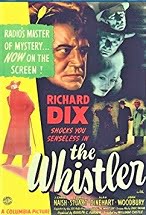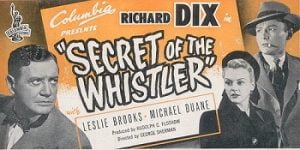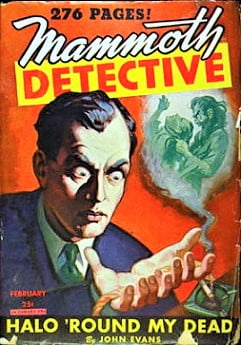
 “I am the Whistler, and I know many things, for I walk by night. I know many strange tales, hidden in the hearts of men and women who have stepped into the shadows. Yes… I know the nameless terrors of which they dare not speak.”
“I am the Whistler, and I know many things, for I walk by night. I know many strange tales, hidden in the hearts of men and women who have stepped into the shadows. Yes… I know the nameless terrors of which they dare not speak.”
The Whistler (1942-55) aired “Danger is a Beautiful Blond” on March 5, 1945 as the 145th of its 760+ episodes (depending on how one counts). It is only the sixth episode of the show we have run, three coming in 2017, the fourth in September of 2019 and the fifth in March of this year. For newcomers, introductory background material on the show is reprised below (it was the most popular west coast radio show for many years), with the background providing context for its not unique but unusual narrative format.
There were two attempts for The Whistler to break into the east coast market that didn’t last long (July-September 1946, and March 1947-September 1948) due to mediocre ratings, so if these episodes are counted as part of the overall scheme of things, the total number of shows ends up somewhere around 769. Over its thirteen-year west coast run it never took a summer break and ran continuously, certainly some kind of record, and its sole west coast sponsor, Signal Gas & Oil remained loyal throughout. While the show had several narrators over the years, the one who held the longest tenure and is most associated with the show was Bill Forman (photo top right).
The Whistler has an interesting backstory, and would take much too long to go into here to give it the justice it warrants. A few points of interest will suffice for this offering of the beloved mystery show, the first of which is the use of the narrator as more than just a host. From Jim Ramsburg’s Gold Time Radio entry on The Whistler: “Like The Shadow’s first personification a dozen years earlier, Inner Sanctum’s ghostly Raymond in 1941 and The Mysterious Traveler in 1943, The Whistler stood outside the stories he narrated. Unlike the others, he used a unique second-person, present tense technique as if to talk directly with the central character of his stories – often an innocent drawn into the plot by circumstances or an amateur driven to murder as a last resort.” A second point of interest has to do with the trademark whistling that opens each episode. From Radio Spirits‘ Blog Archive on The Whistler: “The program featured one of radio’s classic openings: a haunting 13-note theme created by Wilbur Hatch (who also composed the show’s eerie mood music). Hatch estimated that only one person in twenty could whistle this exact melody, and for the show’s thirteen-year duration one person pretty much did—a young woman named Dorothy Roberts. In fact, during the war years, Roberts had to get permission from Lockheed (where she worked) to leave her factory job in order to make it to the program and whistle every week.”
The radio show proved popular enough that Columbia Pictures made eight Whistler films from 1944-48, all but one starring Richard Dix: The Whistler (1944), The Mark of the Whistler (1944), The Power of the Whistler (1945), The Voice of the Whistler (1945), Mysterious Intruder (1946), The Secret of the Whistler (1946), The Thirteenth Hour (1947) and The Return of the Whistler (1948). The show was brought to early television in 1954-55, but never caught on. Nevertheless (and due in great measure to roughly 500 of the estimated 700+ original shows still surviving–and the movies still showing up on classic movie tv channels), The Whistler probably enjoys a larger audience today than it did in its heyday during the Golden Age of Radio.
“Danger is a Beautiful Blond” could easily be considered a pure quill noir murder mystery in the vein of almost any of the cases winding up in the lap of Philip Marlowe, Sam Spade, or any number of others devoted to the art of sleuthing. It begins with a man taking a walk when a beautiful young blond driving a sexy convertible pulls alongside him and talks him into letting her give him a ride. They end up at the obviously well off young woman’s palatial mansion, alone–and then her bedroom–where it looks like our gullible but now cautious male is in for a good time. Think again. Before he knows it, our sucker for a pretty face is involved in dark doings and is fighting for his life. As I said, as the plot unfolds it reads like many a noir murder mystery with secrets and complications aplenty, with a denouement just as worthy and unexpected as many of the best of them. I challenge you to name the murderer in this one.

Play Time: 29:53
{Unaware that the end of WW II in the Pacific was but a mere 6 months away, when two atomic bombs would be dropped on Japan on August 6th and 9th, 1945, the neighborhood gang went about their school lessons as best they could, yet were always ready to invade the nearby newsstand when the sound of the bell signaled the end of their final class of the day. The Whistler episode had whetted their appetite for more of the same, so having read all of their SF magazines for March their nickels and dimes went for the following detective magazines. Black Mask (1920-51) was one of the top tier detective magazines and deservedly so, for it featured many of the premiere writers (and their now-famous characters) in the business. It was a bi-monthly in 1945. Mammoth Detective (1942-47) began with the best of intentions, promising over 300 pages of the finest material per issue, but the paper shortage during World War II hit it particularly hard and the page count dwindled along with the number of issues. Though the quality remained eminently readable, economic pressures were too much for it and it folded after only 33 issues. [I was surprised to learn that Raymond A. Palmer (also Amazing Stories editor) was the editor of Mammoth Detective, and the cover story ostensibly by a “John Evans,” was in fact a pseudonym for Howard Browne. Browne was managing editor of Amazing and Fantastic Adventures under Palmer from 1942 until Palmer left in 1949, whereupon he became editor. He immediately dropped the Shaver Mystery stories that Palmer loved but fans hated, and before he left for Hollywood in 1956 changed Amazing‘s format to a digest.] Mammoth Detective was a quarterly in 1945. Popular Detective (1934-53) was one of the longest-running detective pulps. It stretched over three decades with reliably high quality material no doubt a major factor in its longevity. It was a bi-monthly in 1945.}
[Left: Black Mask, March 1945 – Center: Mammoth Detective, Feb. 1945 – Right: Popular Detective, Feb. 1945]



To view the entire list of weekly Old Time Radio episodes at Tangent Online, click here.